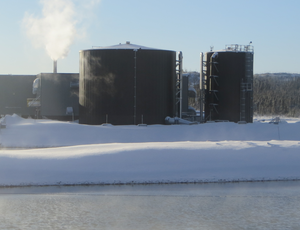Wastewater Treatment Using MBBR in Cold Climates
Biological wastewater treatment in cold climates can be a challenge due to the low reaction rates; however the alternative of heating large flows of wastewater results in significant operating costs.
Using a fixed biomass instead of a suspended biomass allows the process to be operated at much lower temperature as sludge age is no longer a designing parameter. The MBBR (Moving Bed Biofilm Reactor) is a preferred example of such a fixed film (or "attached growth") process. Biomass develops on the inner surface of a carrier which is in continuous movement in the reactor.
Extensive laboratory trials have been undertaken using the MBBR process to demonstrate that long term nitrogen removal can be sustained down to 4°C and selenium removal can be sustained down to 7°C. Results from 2 separate studies treating mine effluents are presented.
The first case study refers to a 2 stage MBBR system treating synthetic water to simulate a mine effluent containing 8 mg/l NH4-N and 18 mg/l N-NO3 where complete nitrogen removal was sustained at 4°C for a period of 3 months. The second case study refers to a trial using a mine effluent containing 25 mg/l N-NO3 and 45µg/l Total Se. A 2-stage MBBR was used to remove both nitrate and selenate at an operating temperature of 7°C.
The storage of tailings from mineral processing operations is achieved in large impoundment areas (variously known as tailings ponds, tailings storage facilities or tailing impoundment areas). While specific regulations vary between sites, mines are not allowed to discharge water acutely toxic to specific species of fish such the rainbow trout (Oncorhynchus mykiss) or invertebrates such as Daphnia magna, and discharge limits are being increasingly tightened. Treatment for the removal of metals, nitrogen(ammonia and/or nitrate and nitrite, principally contributed by ANFO explosive used in blasting) as well as chloride, sulphate and/or total dissolved solids (TDS) is increasingly required prior to discharge to meet regulatory standards.
Biological treatment has been applied for many years to remove nitrogen from municipal effluent, even at cold temperatures. With a growing need for nitrogen removal from tailings ponds, laboratory studies have been undertaken to determine whether nitrification/ denitrification could be sustained at very low temperatures (<5°C) to reflect the conditions of Canadian mines.
In recent years, selenium present in mine effluents as selenate and selenite has also become a concern. Selenium is highly toxic to aquatic life (Chapman et al, 2009) and the discharge limitations for total selenium are becoming increasingly stringent. Some discharge criteria for release of mine effluent into fresh water systems have been set to < 4.7 µg/l Total Se. Selenate is challenging and costly to remove with physico-chemical methods, but biological treatment has presented itself as a viable alternative over the past years. The process of biological reduction of selenate and selenite is very similar to denitrification. Experiments have shown that a denitrifying sludge can be acclimatized to reduce Se compounds (Takada et al 2008). During biological selenium reduction, microorganisms utilize selenate and selenite as electron acceptors. Selenate and selenite are reduced to particulate elemental selenium. Particulate elemental selenium can either be found as nanospheres inside the cell or external to the cell (Oremland et al, 2004) and thus can be separated from the wastewater by traditional liquid-solid separation methods. As with denitrification, biological treatment of selenate and selenite requires anoxic conditions and the presence of an electron donor, usually an organic carbon compound.
Laboratory studies have been undertaken to use the experience gained in operating MBBR for denitrification to develop a reliable process for selenate and selenite reduction. Operation at low temperature has also been studied.



